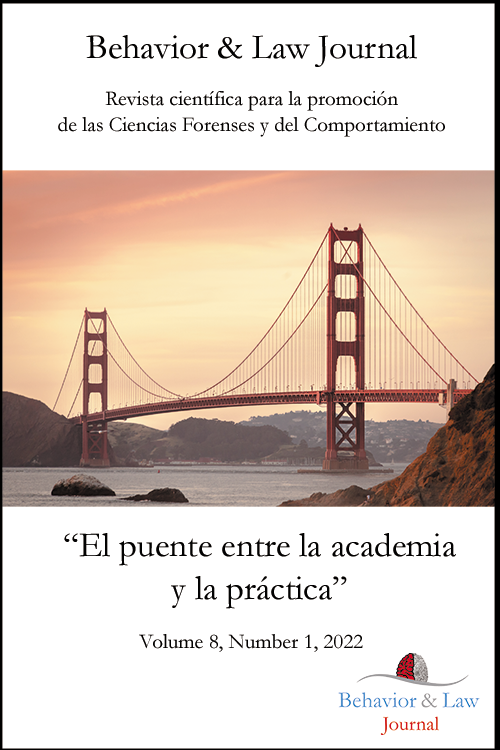Abstract
Criminal profiling techniques are immersed in a state of review in terms of their methodologies and theoretical assumptions. Its empirical contrast, its expert value and its validity as police investigation tool are debated. The pillars on which their principles largely rest, such as the homology thesis, the ideas of consistency and behavioral differentiation, face conflicting evidence. For this reason, two major concerns have arisen regarding the criminal profiling technique: its usefulness and its methodological rigor. To resolve this situation, is necessary an in-depth review of their proposals and the use of those that prioritize methodological rigor with an objective of verifiable utility without the need to accept psycho-criminological theories that have not been sufficiently contrasted. One of these proposals is the VERA Method for the elaboration of psychological profiles of unknown aggressors, developed with a vocation of utility without renouncing the contributions of the scientific method.
References
Berbell, C. & Ortega, S. (2003). Psicópatas criminales. Los más importantes asesinos en serie españoles. Madrid: La Esfera de los Libros.
Canter, D.V. & Fritzon, K. (1998). Differentiating arsonists: a model of firesetting actions and characteristics. Legal Criminol Psychol, 3, 73–96.
Chifflet, P. (2015). Questioning the validity of criminal profiling: An evidence-based approach. Australian & New Zealand Journal of Criminology, 48(2), 238-225. DOI: 10.1177/0004865814530732
Doan, B. & Snook, B. (2008). A Failure to Find Empirical Support for the Homology Assumption in Criminal Profiling. Journal of Police and Criminal Psychology, 23, 61-70. DOI 10.1007/s11896-008-9026-7
George, J.A. (2008). Offender Profiling and Expert Testimony: Scientifically Valid or Glorified Results? Vanderbilt Law Review, 61,1, 221-260.
Godwin, M. (2002). Reliability, Validity, and Utility of Criminal Profiling Typologies. Journal of Police and Criminal Psychology, 17(1), 1-18.
Häkkänen, H., Puolakka, P. & Santilla, P. (2004) Crime scene actions and offender characteristics in arsons. Legal Criminol Psychol, 9, 197–214.
House, J.C. (1997) Towards a practical application of offender profiling: the RNC’s criminal suspect prioritization system. J.L. Jackson & D.A. Bekerian (eds.), Offender profiling: theory, research and practice. Chichester (UK): Wiley, 177–190.
Ibáñez Peinado, J. (2010). El perfil criminal (“criminal profiling”). J. Ibáñez Peinado (coord.), Técnicas de investigación criminal. Madrid: Ministerio del Interior; Dykinson, 205-234.
Jackson, J.L., Van Kopen, P.J., & Herbrink, J.C.M. (1993). Does the service meet the needs? An evaluation of consumer satisfaction with specific profile analysis and investigative advice offered by the Scientific Research Advisory Unit of the National Criminal Intelligence Division (CRI). Amsterdam (The Netherlands): Netherlands Institute for the Study of Criminality and Law Enforcement.
Janosch González, H. (2020). Agresiones sexuales cometidas por desconocidos. Una investigación empírica. Madrid: UNED, Dykinson.
Kocsis, R.N. (2003). Criminal psychological profiling: Validities and abilities. International Journal of Offender Therapy and Comparative Criminology, 47, 126–144.
Kocsis, R.N., Irwin, H.J., Hayes, A.F., & Nunn, R. (2000). Expertise in psychological profiling: A comparative assessment. Journal of Interpersonal Violence, 15, 311–331.
Kocsis, R.N., Hayes, A.F., & Irwin, H.J. (2002). Investigative experience and accuracy in psychological profiling of a violent crime. Journal of Interpersonal Crime, 17, 811–823.
Kocksis, R.N. & Palermo, G.B. (2007). Contemporary Problems in Criminal Profiling. R.N. Kocsis (ed.), Criminal Profiing. International Theory, Research and Practice. Totowa (NJ, USA): Humana Press, 327-346.
Meyer, C.B. (2007). Criminal Profiling as Expert Evidence?: An International Case Law Perspective. R.N. Kocsis (ed.), Criminal Profiing. International Theory, Research and Practice. Totowa (NJ, USA): Humana Press, 207-248.
Mokros A. & Alison L.J. (2002) Is offender profiling possible? Testing the predicted homology of crime scene actions and background characteristics in a sample of rapists. Legal Criminol Psychol, 7, 25–37.
Peña, L. (2012). La naturaleza dual del proceso diagnóstico y su vulnerabilidad a los sesgos cognitivos. Revista Médica de Chile, 140(6), 806-810. http://dx.doi.org/10.4067/S0034-98872012000600017
Ressler, R. & Schachtman, T. (1992). Whoever Fights Monsters. My twenty years tracking serial killers for the FBI. New York (NY, USA): St. Martin’s Paperbacks.
Ressler, R. & Schachtman, T. (1997). I Have Lived in the Monster. New York (NY, USA): St. Martin’s Paperbacks.
Rodríguez-Ferreiro, J y Barbaría, I (2018) Sesgos cognitivos y convicciones morales. Ciencia cognitiva. DOI: http://hdl.handle.net/2445/162658
Snook, B., Taylor, P.J. & Benell, C. (2007). Criminal Profiling Belief and Use: An Study of Canadian Police Officer Opinion. The Canadian Journal of Police and Security Services, 5(3), 1-11.
Soto, J. E. (2019). Profiler. Los secretos del análisis de conducta criminal. Madrid. Editorial Pirámide.
Soto, J. E. (2017, 2ª ed.) Manual de Investigación Psicológica del Delito. El Método VERA. Madrid. Editorial Pirámide.
Turvey, B.E. (1999). Criminal Profiling: An Introduction to Behavioral Evidence Analysis, London (UK): Academic Press.
Turvey, B.E. (2012). Criminal profiling: An introduction to behavioral evidence analysis. London (UK): Elsevier.
Woodhams, J. & Toye, K. (2007) An empirical test of the assumptions of case linkage and offender profiling with serial comercial robberies. Psychology Public Policy & Law 13,59–85.

This work is licensed under a Creative Commons Attribution-NonCommercial-NoDerivatives 4.0 International License.
Copyright (c) 2022 Behavior & Law Journal

